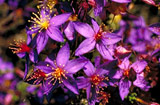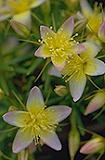|
[Front Page] [Features] [Departments] [Society Home] [Subscribe]

Growing Calytrix
Gwyn Clarke
The Calytrix or Star flowers are rarely seen in gardens, except for Calytrix tetragona, and most people would not realize that there are over 70 species growing in the wild. They are quite spectacular when in flower and have colourful calyces to follow. The most commonly grown species, C.tetragona is very widespread and variable. Other species may be available from time to time at specialist nurseries.
 |
|
Fringe myrtle, Calytrix tetragona is a widespread species and is found in woodlands and forests from southern Queensland to south Western Australia.
The white form (top) is most commonly seen but pink forms (bottom) are also found, particularly in western Victoria.
Select the thumbnail image or highlighted name for a higher resolution image (30k and 32k). Photos: Brian Walters; Geoff Clarke
|
 |
Why then have these plants not been seen more often in cultivation?
Availability
Since many of the species come from Western Australia obtaining plant material has not been easy. Seed has generally proved to be of low viability. Perhaps the seed was old, had dormancy factors or germination inhibitors or sustained considerable insect damage. When seed has germinated it has been slow to grow on and has had poor root systems. Cutting material has given greater success as far as eastern States' species are concerned. When material from Western Australia has been obtained it has been generally more difficult to strike, and certainly more difficult to maintain plants in the ground, however pot culture is a different story.
| |

|
| |
Some forms of C.tetragona produce colourful calyces which persist after the flowers have finished.
|
Experimenting with Western Australian Seed
I purchased seed from Nindethana Seed Company in Western Australia. The seed of Calytrix is indehiscent with calyx and awns present. The calyx and awns were removed, and the seed pushed into the soil point first. The top of the seed should be level with the soil. The seed was watered by lowering the seed punnet into the water until water level was at the top of the punnet, the seed punnets were then placed in a capillary bed.
Air movement around the seed punnets was important as seedling Calytrix are very prone to fungal attack. The seedlings were kept inside the house with underfloor heating operating. The temperature in the room varied between 15 and 23 degrees C. This was done because it was winter in Canberra and I had no other suitable facilities.
Germination time was very variable, C.angulata appearing after six weeks and C.aurea after 13 months. Plants should be potted on as soon as practicable.
| |

Calytrix leschenaultii
|

Calytrix depressa
|
| |
Select the thumbnail image or highlighted name for a higher resolution image (39k and 26k). Photos: Brian Walters; Geoff Clarke
|
|
I had success germinating the following species: C.angulata, C.glutinosa, C.leschenaultii, C.exstipulata, C.fraseri and C.depressa. C.aurea only produced one seedling which died before reaching a usable size.
The seedlings were potted on and there were the usual losses. Most of the living seedlings grew until they were about 2.5 cm high. Then they just sat there. Some damped off and I was afraid I was going to lose all of them, but a suggestion from a friend helped save some of them - see below. (I should mention that I haven't really spent much time working on seed of eastern states species. This is because they are generally easier to get hold of and grow very well from cuttings. I have certainly had seedlings of C.tetragona popping up in my garden.)
Experimenting with Cuttings
Lyn Craven suggested I take cuttings from the above seedlings as this might help break their dormant state. This proved to be the case. The cuttings taken were 2 cm long, with about 4-5 pairs of leaves. They were prepared in the usual way, care being taken not to damage the delicate stem. They were placed around the edge of a black pot in a mix of 2/3 washed river sand and 1/3 peat. The pot was then placed in the hot bed, (by this time I didn't need my underfloor heating anymore).
Within 10 days most of the cuttings had roots and were potted up. I used the hot bed because this material was quite soft. That was in January 1985. Most of those plants lived for 7-8 years in the garden; Calytrix angulata is still alive and flowers each year in a raised bed. The others were quite happy in pots for even longer and some were given to the new leaders of the Calytrix Study Group when I retired. All the plants eventually flowered. Plants included the following species, C.angulata, C.glutinosa, C.leschenaultii and C.depressa.
Since first writing this article in 1990 I have done a lot more experimenting with cuttings, and while the information for using soft young growth remains the same, cuttings can be struck from older material.
| |

Calytrix longifolia |
| |
Select the thumbnail image or highlighted name for a higher resolution image (32k).
Photo: Geoff Clarke
|
Cuttings of Calytrix may be taken from young growth before it becomes woody. Small cuttings, i.e., 4-5 cm, do very well, but they can be longer. I have used liquid hormone, 1000 ppm IBA/250 ppm NAA, but have also had good results without hormone. Cutting mix was 4 parts washed river sand, 4 parts perlite, 1 part peat. However, any well drained and aerated mix will do. Some will do well in the hot bed, but many prefer open shade with low humidity even though they take a little longer to form roots; e.g. C.longiflora from Queensland, and many forms of C.tetragona. Timing is also important, and I have found December/January an excellent time in Canberra, but cuttings may be taken as late as April.
Success may also be had with woody cuttings. They respond well to IBA4000 and open shade. It may be that different times are more appropriate in warmer climates. The important thing is to be flexible and experiment to find the best conditions where you live.
Calytrix in the Garden
Interesting species in this genus have often proved short lived in cultivation, and susceptible to grey mould. However, given the correct conditions, Calytrix can do well and live for a reasonable length of time. The eastern states species, (many forms of C.tetragona, and C.alpestris), are quite long lived and even some of the Western Australian species have lived 7-8 years. C.acutifolia and C.angulata from the west are 10 and 15 years old respectively. In more humid climates than Canberra the fungal diseases may pose more of a problem.
Calytrix like good drainage, in sun or semi-shade and enjoy living close to other species. They also like a spot with plenty of air movement as this helps prevent grey mould. I have mine in garden beds with gypsum and washed river sand added, or in raised beds made of washed river sand, peat, compost and local clay. Raised beds are particularly important for species from Western Australia. All the beds are mulched with sand or an open mix of stems twigs and leaves. This allows good aeration round the stem and prevents collar rot. Some mulches pack down hard around the stem and should be avoided.
Calytrix should also be pruned lightly and regularly to avoid woodiness. If a plant should become woody, heavy pruning can restore vigour. Plants doing well in the described environment include upright, procumbent and prostrate forms of C.tetragona, and C.alpestris, C.angulata, C.acutifolia, and C.depressa.
Pot Culture of Calytrix
Many species make excellent pot plants. All those I have in pots are doing well. They do not require repotting too often (about every two or three years) and respond well to regular watering with half strength Aquasol, or other liquid fertilizer. You do need to be careful with species that like sun and good air movement. I recently lost two C.longiflora from fungal attack because they were in a shady protected spot when they really needed full sun. My son's plant is doing well in a very sunny courtyard.
Horticultural Potential
Calytrix, with their dainty star flowers are really worth growing, and with a little care they can be propagated and maintained in the garden. They are outstanding in flower although the flowering period can be quite short, but the colourful calyces which follow are as delightful as the flowers themselves.
 |
 |
|
Calytrix have outstanding horticutural potential due to their (usually) moderate size and a dense mass of flowers. Shown here is Calytrix strigosa in close up (left) and as a example of the dense flowering habit (right).
Select the thumbnail image or plant names for higher resolution images (44k and 57k).
Photos: Geoff Clarke
|
We are only at the beginning of the development of these plants for horticulture. There are still many things to be discovered, and many experiments to be attempted. Cross pollination between species could produce plants with larger flowers or extend flowering times. The robust qualities of Calytrix tetragona could perhaps be passed on to its more fragile relatives. Grafting, budding and tissue culture have yet to be attempted.
Anyone can be part of the development of and the experimentation with this genus. These little gems will reward you with their colourful flower displays, bright calyces and scented leaves. I have even found seedlings growing happily under the parent plants. My latest is a low growing form of C.tetragona with a large, soft, pink flower. Its parents - a prostrate pink form with tiny crowded flowers and a tall white form (3m high) with large white flowers. What greater reward could you ask?
This article is updated from Gwyn's original article Growing Calytrix published in "Australian Plants", June 1990. Gwyn is a former leader of ASGAP's Calytrix Study Group which is currently in recess.

[Front Page] [Features] [Departments] [Society Home] [Subscribe]
Australian Plants online - March 2001
Association of Societies for Growing Australian Plants
|